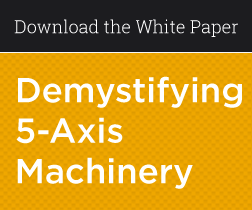7 Things to Look for in a 5 Axis Machining Center
Posted by
Mike Williams on Tue, Jan 08, 2013
 Investing in a 5 axis machining center makes good economic sense for many CNC machine shops. With over 60% of parts produced requiring machining on 5 sides, a 5 axis machine can save operator time per part, costly special fixtures and tools, and precious floor space. It will also increase your spindle usage and your ability to accept more complex parts orders.
Investing in a 5 axis machining center makes good economic sense for many CNC machine shops. With over 60% of parts produced requiring machining on 5 sides, a 5 axis machine can save operator time per part, costly special fixtures and tools, and precious floor space. It will also increase your spindle usage and your ability to accept more complex parts orders.
However, choosing the right 5 axis CNC machine for your specific requirements involves making a number of important decisions. Here are 7 key issues to consider:
- Simultaneous 5 axis or 3+2? In simultaneous 5 axis machining all 5 axes are engaged at the same time to perform complex operations on such parts as turbine blades, impellers and aerospace airframes. Machining these kinds of parts requires the 5 axes (3 linear and 2 rotary) to move at the same time during the cutting process to achieve the desired geometry. On the other hand, in 3 + 2, or 5 axis positional machining, one or more of the X, Y & Z axes move simultaneously while the remaining two axes are indexed into position and do not move during that segment of the machining program. In 3 + 2 machining the CNC program rotates one or two rotary axes into position and locks them in place while the X, Y & Z axes perform the cutting necessary to achieve the desired geometry. Typical applications for 3 + 2 machining include aerospace manifolds, and multi-sided and compound angle holes.
- Power and rigidity. The majority of 5 axis work involves parts that require holding tight tolerances. High accuracy machining requires a 5 axis machine with a rigid spindle and tool holder to eliminate the vibrations that cause out-of-tolerance parts. It’s also important that the machine can maintain a constant cutting feed rate and that the machine’s control is capable of maintaining consistent acceleration and deceleration, while quickly processing data.
- Programming. Simultaneous 5 axis machining is more complicated than programming 3 axis machining due to the greater flexibility in tool path options. However, with the proper training, an operator with solid programming experience can learn to program a 5 axis machine, so it’s important that training is available from experienced programmers. And since most users of 5 axis machines use CAM software for programming, make sure the machine you select is compatible with your CAD/CAM software.
- Collision avoidance. Crashes can be costly, both in terms of damage to parts and equipment, and lost production time. With 5 axes in motion, the opportunity for crashes increases. 5 axis machines equipped with Okuma’s Collision Avoidance System, for example, take the worry out of machine crashes, and significantly reduce set-up time.
- Thermal deformation. Dealing with thermal deformation can be a time-consuming activity for the 5 axis machine operator, often involving many test runs to compensate for the affects of ambient workplace temperatures, heat produced by the machine itself, and heat generated by the machining process. Nothing can prevent these temperature variations from occurring, so anyone considering investing in a 5 axis machine should consider selecting a machine that is designed to compensate for temperature variations, like the Okuma 5 axis machines that incorporate the Thermal Friendly Concept.
- Technical service and customer support. 5 axis machining requires more than excellent equipment. It also requires operator training, preventative maintenance, readily available spare parts and responsive technical service when required. Anyone can sell you a machine tool, but very few organizations can provide 24/7 technical support, experienced applications specialists and knowledgeable trainers, and millions of dollars in spare parts, like Gosiger can.
- Financial Considerations. Any major investment requires taking a careful look at the cost justification for the purchase, and the financing or leasing options. Gosiger’s applications specialists can analyze your requirements for 5 axis machining and create a cost comparison to alternative manufacturing methods so you can see if the purchase makes sound financial sense. And Gosiger’s Connext financial experts can find you the best possible purchase or lease plan.
Is 5 axis machining right for you? If so, one call to Gosiger can help you make an informed purchase decision by providing the facts you need for these 7 important issues and others. Give them a call today.